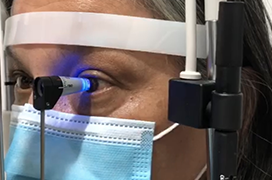Excimer laser refractive surgery is a procedure performed worldwide to solve refractive errors and reduce dependence on glasses or contact lenses. There has been an increase in the number of procedures performed around the world. Myopia is the most common indication for corneal photorefractive surgery. Myopic patients have a higher risk of developing some type of glaucoma in their lifetime, such as primary open-angle glaucoma and others. Refractive surgery ablates central corneal stromal tissue, altering its thickness and biomechanics, which in turn makes it difficult to accurately measure intraocular pressure (IOP), since it underestimates it. This underestimation of IOP may delay the diagnosis of de novo glaucoma in patients with a history of refractive surgery. Each patient who wishes to undergo corneal refractive surgery should undergo a thorough glaucoma examination in order to monitor and detect the possible development and / or progression of glaucoma. A very useful practical approach is to perform a series of IOP measurements before and after surgery, when the eye is already stable, and the difference between the averages of the two sets of readings can then be used as a personalised correction factor for postoperative IOP monitoring in that eye. Also, if there is any suspicion of a possible glaucoma, paraclinical tests, such as coherent optical tomography of the retinal nerve fibre layer (RNFL), visual fields and photos of the optic nerve should be requested.
All this data prior to refractive surgery should be provided to these patients, so that they can save it and give it to their treating ophthalmologists in the future.
- Photorefractive surgery with excimer laser and its impact on the diagnosis and follow-up of glaucoma. A review
- OCT Angiography, Visual Field and RNFL With Different Kinds of Medication for Hypertensive Glaucoma
- Treatment Options for Premacular and Sub-Internal Limiting Membrane Haemorrhage
- Comparison of Optical Biometers Argos and IOL MASTER 700
- Paraneoplastic Optic Neuropathy as an Initial Clinical Manifestation of Small Cell Lung Cancer. A Case Report
- Intraocular Lymphoma with Retrobulbar Infiltration. A Case Report

